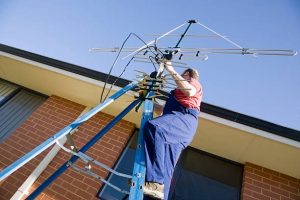Antenna Installation Tips You Need to Know
Whether you are a seasoned pro or an aspiring telecommunications technician, you need to know a few antenna installation tips. For one, the RF path needs to be clear and free from obstructions, and the ground system should have low electrical resistance. Another tip is to ensure that the tower’s reflection angles are symmetrical.
Make sure the RF path is clear of obstructions
An unobstructed RF path is the best way to get the best possible signal. It is also an important safety precaution, as many people are electrocuted each year while installing antennas.
 There are two primary types of obstructions in a wireless network: artificial and natural. Natural obstructions include trees, mountains, hills, and another terrain. As for artificial obstructions, there are a variety of materials, including concrete, metal, drywall, and wood block.
There are two primary types of obstructions in a wireless network: artificial and natural. Natural obstructions include trees, mountains, hills, and another terrain. As for artificial obstructions, there are a variety of materials, including concrete, metal, drywall, and wood block.
One of the first things to consider is what material is used to construct the structure. The building may have mixed conductor and insulator properties if it is made of reinforced concrete. The type of insulator is also a consideration.
An antenna high enough to clear the obstructions in its path is optimum. A low mast may disturb the Fresnel zone, reducing performance and range.
The best time to install an antenna is during winter when tree growth is slow, and leaves aren’t present. This is the best time to test the RF path for obstructions.
You should wear rubber-soled shoes and a long-sleeved shirt when installing an antenna. Avoid using a metal ladder, as this can interfere with an incoming antenna signal.
A slew of software is available to ensure proper Fresnel zone clearance in line-of-sight wireless systems. A good example is a handheld GPS unit, which can help you calculate the distance between radio links. A watt meter can help you determine a transmission line’s forward and reflected power, which is a necessary component of an efficient RF system.
The simplest RF signal will travel similarly to free space, so it is important to ensure the RF path is clear of any obstructions before installing an antenna.
Ensure the ground system has a low electrical resistance
Ensure the ground system has a low electrical resistance. This is important for reducing the chance of damage from lightning and static discharges. It also reduces the possibility of an electrical shock, fire, or other electrical damage.
The National Electrical Code (NEC) guides this topic. Part II of the Code lists the dos and don’ts for power systems under 1kV. The code also limits voltage from lightning surges and line surges.
Typical grounded systems use electrodes in parallel with ground rods. This works well when all metal objects reference the same ground potential. However, if there is a change in capacitance between lines and the earth, such as from lightning strikes, the connection between the lines and the ground will not be effective.
The NEC requires most low-voltage power systems to be grounded. The purpose of grounding is to make the entire system safer. It prevents damage to industrial plants and equipment and improves reliability.
If the soil is too hard, corrosive, or wet, it can eat away at the grounding rods. A good inspection program is essential to ensuring the continuity of the grounding system.
A low-resistance grounding system can limit the ground fault current to 100 to 1000 amps. This will protect the protective devices from being tripped and limit the ground fault current to less than 25% of the three-phase fault current.
High-resistance grounding is typically used in retrofits of previously ungrounded systems. This is an effective solution for limiting the ground-fault current, but it also has the same risks as low-resistance.
During installation, the resistance of the ground system is determined with an approved ground testing instrument. This is known as the Ground Resistance Measurement Method.
Avoid metal objects in the antenna enclosure
Whether you are putting your antenna module into a metallic enclosure or an external enclosure, you may perform better if you avoid metal objects in the near field. However, there are many other factors to consider when placing components. These are all important to your antenna’s performance.
Aside from placement, the conductivity of the enclosure can also cause problems. You should also remember that the conductive surface becomes charged when it comes into contact with an electromagnetic field. You can avoid this by using non-metallic paint on the plastic enclosure. You can also use a heavy-duty metal enclosure for durability and protection.
Antennas are not like other electronic components. They have different requirements for placement and tuning. Therefore, you will need to make sure that you understand all of the rules and regulations associated with the antenna. You will also need to verify that your component complies with the FCC.
Another rule to remember is that large metals should not be placed in the near field. This can drastically alter the radiation pattern. The best practice is to place metal orthogonal to the antenna. Placing metal parallel to the module’s plane is also not recommended. This is because this can form an image antenna. This interference is destructive and can be harmful to your antenna.
Lastly, you must ensure proper clearance between the antenna and the enclosure. You can clear the antenna with as little as 2mm, but for the best results, you should allow at least 5mm. If you can’t make this clearance, you can place the antenna in a shield.
You May Also Like
